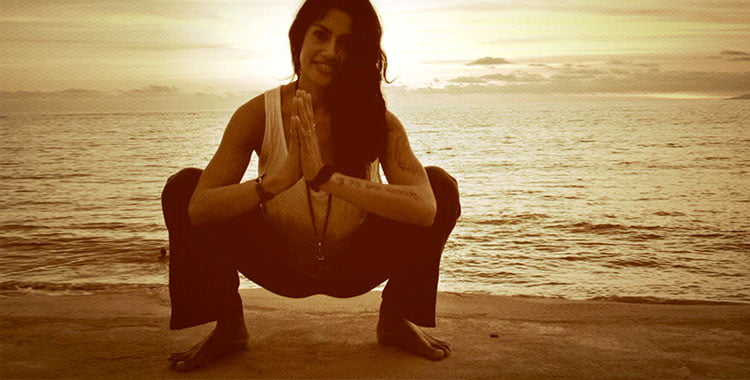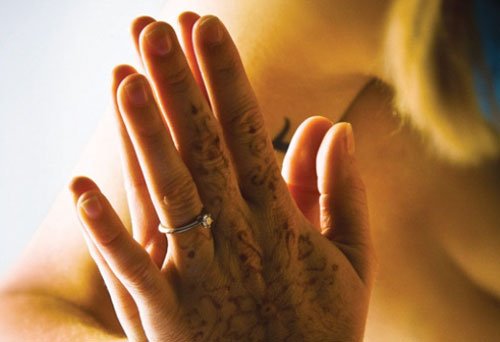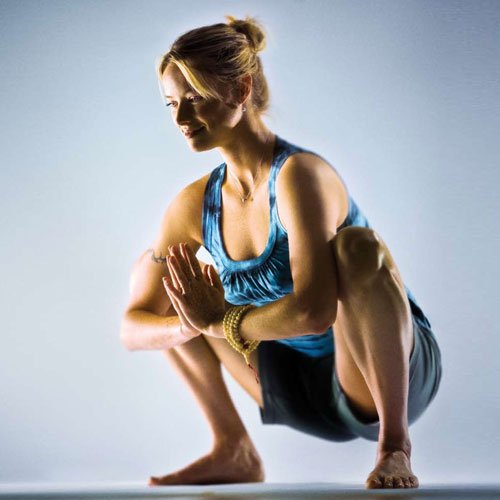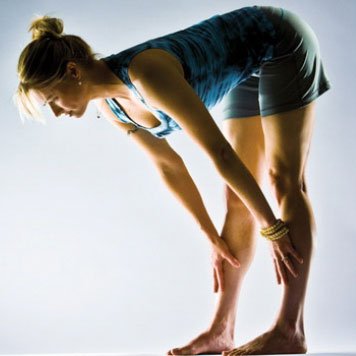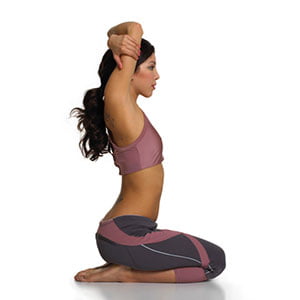How to do Malasana, Garland Pose: hip opening & stretching yoga pose.
Malasana, Garland Pose – this deep squat with the feet together is extremely beneficial for the muscles, organs and soft tissues of the pelvic abdomen. The legs are enlivened, the hips opened, and the lumbar spine is given a supported stretch.
This simple pose is often an unexpected challenge as hip flexibility is a common issue for many people today. Sitting for long periods can shorten and tighten the inner thighs, groin, and hip flexors — which can cause poor posture and back pain. Malasana, Garland Pose helps to lengthen and open the hips, creating more mobility for all of your daily activities.![]() 1. Begin by standing at the top of your mat in Mountain Pose (Tadasana), with your arms at your sides. Step your feet about as wide as your mat.
1. Begin by standing at the top of your mat in Mountain Pose (Tadasana), with your arms at your sides. Step your feet about as wide as your mat.
2. Bend your knees and lower your hips, coming into a squat. Separate your thighs so they are slightly wider than your torso, but keep your feet as close together as possible. If your heels lift, support them with a folded mat or blanket.
3. Drop your torso slightly forward and bring your upper arms to the inside of your knees. Press your elbows along the inside of your knees and bring your palms together in prayer position (Anjali Mudra). Work toward bringing your hands to your heart centre and your forearms parallel to the floor.
4. Lift and lengthen your torso, keeping your spine straight and shoulders relaxed. Shift your weight slightly into your heels.
5. Hold for five breaths. To release, bring your fingertips to the floor. Then, slowly straighten your legs and come into Standing Forward Fold (Uttanasana).
Modifications & Variations
Garland Pose can provide a deep stretch to your hips and groin! If you’d like to deepen or lighten the pose, try these simple changes to find a variation that works best for you:
- If your heels don’t come to the floor, place a folded, firm blanket or rolled yoga mat underneath them.
- Experienced students may step their feet completely together.
- Women who are pregnant and those who need help balancing have a few options:
- Rest both hands on the back of a chair.
- Rest one hand along a wall to the side of the body.
- Do the pose with your back against a wall.
- More experienced students can drape the torso between the legs:
- Reach both arms forward, then bend the elbows and bring the shins into the armpits.
- Extend the arms behind your body and clasp the heels.
- Drop the forehead to the mat.

If your heels don’t come to the floor, place a folded, firm blanket or rolled yoga mat underneath them.
Tips
Practicing Garland Pose can be a great way to challenge your balance and loosen tight hips. It might be difficult at first, but with practice, your muscles will lengthen and you will be able to squat. Keep the following in mind when practicing this pose:
- Avoid jerking, pulling, pushing, or forcing any movement in this pose. Let your movements be slow and smooth.
- Do not bounce your hips up and down. Doing so can overstrain your knees and hip flexors.
- Keep shifting your weight back into your heels.
- Lengthen the front of your torso and keep your spine long, not rounded.
Benefits of Malasana, Garland Pose
Malasana stretches the thighs, groin, hips, ankles, and torso. It tones the abdominal muscles and improves the function of the colon to help with elimination. This pose also increases circulation and blood flow in the pelvis, which can help regulate sexual energy. Malasana improves balance, concentration, and focus. Malasana is particularly beneficial for women who are pregnant, as it can later aid in childbirth.
Malasana, Garland Pose counter poses
In yoga we use a counter pose in a sequence; For example, a twist follows a backbend to “neutralise” the spine, or a forward bend follows a backbend to help lengthen the spine and calm the nervous system.

